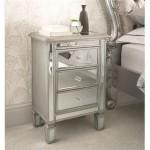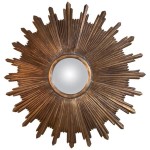Hanging Frameless Mirrors Without Clips: A Comprehensive Guide
Frameless mirrors offer a sleek, modern aesthetic to any space, seamlessly integrating into various interior design styles. Unlike their framed counterparts, frameless mirrors lack the traditional support and mounting mechanisms. This necessitates alternative methods for secure and aesthetically pleasing installation. While clips are a common solution, many prefer a cleaner, almost invisible look. This article provides a comprehensive guide on hanging frameless mirrors without clips, exploring different methods, necessary materials, and crucial considerations for a successful installation.
The absence of a frame requires precise planning and execution to ensure the mirror is securely mounted and remains stable over time. Factors such as the size and weight of the mirror, the type of wall, and the desired aesthetic all influence the choice of hanging method. Different adhesives, mounting tapes, and specialized hardware offer viable alternatives to clips, each with its own set of advantages and disadvantages. A thorough understanding of these options is crucial for selecting the most appropriate solution for a specific project.
Choosing the Right Adhesive or Mounting Tape
Adhesives and mounting tapes provide a direct bond between the mirror and the wall, eliminating the need for visible hardware. When selecting an adhesive, it is paramount to choose one specifically formulated for mirrors. These specialized adhesives are designed to be non-corrosive and compatible with the silvering on the back of the mirror. Using the wrong type of adhesive can damage the reflective coating, leading to discoloration, delamination, and ultimately, failure of the bond. Common types of mirror adhesives include neutral-cure silicone adhesives and acrylic-based adhesives.
Neutral-cure silicone adhesives are known for their flexibility and resistance to moisture, making them suitable for bathrooms and other areas with high humidity. They typically require a longer curing time compared to acrylic-based adhesives but offer superior long-term performance. Acrylic-based adhesives, on the other hand, tend to cure faster and provide a strong initial bond. However, their flexibility may be limited, making them less suitable for walls that are prone to movement or vibration.
Mirror mounting tapes offer an alternative to liquid adhesives. These tapes consist of a double-sided adhesive with a strong, pressure-sensitive bond. They are easy to apply and provide instant adhesion, eliminating the need for temporary supports during the curing process. However, the weight-bearing capacity of mounting tapes is typically lower than that of liquid adhesives. Therefore, it is crucial to select a tape with sufficient strength to support the mirror's weight. Always check the manufacturer's specifications for weight limitations and ensure that the surface is clean and properly prepared before application.
Regardless of the chosen adhesive or tape, it is essential to apply it evenly across the back of the mirror. This ensures uniform distribution of weight and prevents stress concentrations that could lead to cracking or detachment. Follow the manufacturer's instructions carefully regarding application techniques, curing times, and surface preparation requirements. Proper surface preparation is crucial for achieving a strong and durable bond.
Utilizing French Cleats for Secure Mounting
French cleats offer a robust and versatile method for hanging frameless mirrors without clips. A French cleat consists of two interlocking pieces of wood or metal, one attached to the wall and the other to the back of the mirror. The angled design of the cleats allows the mirror to hang securely against the wall, distributing the weight evenly and providing a stable mounting solution. This method is particularly suitable for larger, heavier mirrors that require extra support.
The key to a successful French cleat installation is precise alignment and secure attachment of both cleats. The wall cleat should be securely fastened to the wall studs, ensuring that it can support the weight of the mirror. If studs are not available in the desired location, use appropriate wall anchors designed for heavy objects. The mirror cleat should be attached to the back of the mirror using a strong adhesive, such as a mirror-specific adhesive, and mechanical fasteners, such as screws. Pre-drilling pilot holes is recommended to prevent cracking or chipping the mirror.
When attaching the mirror cleat, ensure that it is positioned correctly to allow for proper alignment with the wall cleat. Use a level to ensure that both cleats are perfectly horizontal, preventing the mirror from appearing tilted. Once the cleats are securely attached, simply lift the mirror and slide the mirror cleat onto the wall cleat. The interlocking design will hold the mirror securely in place. This method allows for easy removal of the mirror for cleaning or relocation, simply by lifting it off the cleat.
French cleats offer a clean and minimalist aesthetic, as the cleats are hidden behind the mirror. They also provide a degree of adjustability, allowing for minor corrections in alignment after the mirror is hung. This method is particularly advantageous for uneven walls, as the cleats can be shimmed to compensate for irregularities. The robust design of French cleats makes them a reliable and long-lasting solution for hanging frameless mirrors.
Proper Wall Preparation and Mirror Handling
Regardless of the chosen hanging method, proper wall preparation is paramount for a successful and secure installation. The wall surface must be clean, dry, and free of dust, grease, and loose paint. Use a mild detergent and water to clean the wall, followed by a thorough rinsing with clean water. Allow the wall to dry completely before proceeding with the installation. For painted surfaces, lightly sand the area where the adhesive or mounting tape will be applied to improve adhesion. Remove any loose paint or wallpaper.
If the wall surface is uneven or textured, consider applying a thin layer of drywall compound to create a smooth surface. This will ensure that the adhesive or mounting tape makes full contact with the wall, maximizing the bond strength. Allow the drywall compound to dry completely before sanding it smooth. Prime the repaired area with a paint primer to seal the surface and improve adhesion.
Handling frameless mirrors requires extreme care to prevent damage. Mirrors are fragile and can easily crack or shatter if dropped or mishandled. Always wear gloves to protect your hands and prevent fingerprints on the mirror surface. Use a suction cup handle to lift and maneuver the mirror safely. Avoid placing the mirror directly on hard surfaces, as this can scratch or chip the edges. Use padding, such as blankets or cardboard, to protect the mirror during transport and installation.
When applying adhesive or mounting tape, work in a well-ventilated area and follow the manufacturer's safety precautions. Avoid getting adhesive or tape on the mirror surface, as it can be difficult to remove. If adhesive does get on the surface, use a clean, damp cloth to wipe it off immediately. After the mirror is hung, inspect it carefully for any signs of damage or instability. If any issues are detected, address them promptly to prevent further damage or accidents.
Choosing the right hanging method and executing the installation with meticulous attention to detail will ensure that the frameless mirror is securely mounted and enhances the aesthetic appeal of the space for years to come. Regular inspection and maintenance will help to prolong the life of the installation and prevent potential problems.

How To Install A Mirror Without Frame Merrypad

How To Install A Mirror Without Frame Merrypad
:strip_icc()/DesireeBurnsInteriors1-f76d25cad90041c88fbae4a7dc10aab4.jpg?strip=all)
2 Simple Ways To Hang A Frameless Mirror

How To Hang A Frameless Mirror On The Wall With Pictures

How To Hang A Frameless Mirror On The Wall With Pictures

How To Hang A Hanging Mirror Without Accompanying Hardware

Mirror Installation Without Clips

How To Hang A Frameless Mirror June 2024 Your Guide Hanging

How To Hang A Frameless Mirror On Wall

Installing A Mirror Without Ugly Clips








